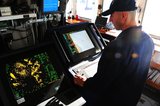Daewoo awards Atlas Thai sonar contract
Daewoo Shipbuilding & Marine Engineering (DSME) has awarded Atlas Elektronik a contract to develop two sonar variations for the Royal Thai Navy’s new frigates.
Announced on 18 December, the award will see Atlas develop and integrate a bow sonar (ASO) as well as a low-frequency active towed array sonar (ACTAS) for the new vessels that DSME was contracted to build in April 2013.
By using the two sonars, the navy will be able to detect, track and classify underwater vehicles such as submarines, torpedoes and UUVs, as well as detecting and classifying small speedboats, divers and floating obstacles.
The ASO bow sonar operates at a frequency ranging between 6 and 9 kHz and provides a surveillance radius of up to 15km around the ship, according to Atlas, which makes it most suitable for the self-protection of the ship.
The ACTAS, meanwhile, operates in a lower frequency range from some 2 kHz, and permits observation of the sea space at ranges above 60 km, depending on the propagation conditions of the water.
‘This gives the sonar an operational range that by far exceeds that of radars and the weapons range of submarines,’ Atlas said in a statement. ‘The system is therefore not only ideal for hunting submarines but also for the wide-area reconnaissance of surface combatants.’
Both sonar systems represent Atlas’ newly-developed signal processing methods, as well as offering a ‘unified hardware design’ with the corresponding servicing and support, the company said.
More from Digital Battlespace
-
![Babcock nears first customer for Nomad AI translation tool]()
Babcock nears first customer for Nomad AI translation tool
Nomad can provide militaries with real-time intelligence, saving critical time on the battlefield.
-
![AUSA 2025: Israel’s Asio Technologies to supply hundreds of improved Taurus tactical systems]()
AUSA 2025: Israel’s Asio Technologies to supply hundreds of improved Taurus tactical systems
Taurus operates alongside the Israel Defense Forces’ Orion system which supports mission management across tens of thousands of manoeuvring forces, from squad leaders to battalion commanders.
-
![AUSA 2025: Kopin pushes micro-LED plans as China moves faster]()
AUSA 2025: Kopin pushes micro-LED plans as China moves faster
The plan for the new displays follows fresh investment in Kopin’s European facilities by Theon and an order for head-up displays in fielded aircraft, with funding from the US Department of Defense.
-
![AUSA 2025: Persistent Systems to complete its largest order by year’s end]()
AUSA 2025: Persistent Systems to complete its largest order by year’s end
Persistent Systems received its largest ever single order for its MPU5 devices and other systems earlier this month and has already delivered the 50 units to the US Army’s 4th Infantry Division.
-
![Aselsan brings in dozens of companies and systems under the Steel Dome umbrella]()
Aselsan brings in dozens of companies and systems under the Steel Dome umbrella
Turkey has joined the family of countries attempting to establish a multilayered air defence system with government approval in August 2024 for the effort landed by Aselsan. Dubbed Steel Dome, the programme joins Israel’s Iron Dome, the US Golden Dome, India’s Mission Sudarshan Chakra and South Korea’s low-altitude missile defence system.
-
![DSEI 2025: MARSS unveils new agnostic multidomain C4 system]()
DSEI 2025: MARSS unveils new agnostic multidomain C4 system
MARSS’ NiDAR system has been deployed using sensors from static platforms to provide detection and protection for static sights, such as critical infrastructure, ports and military bases.




























